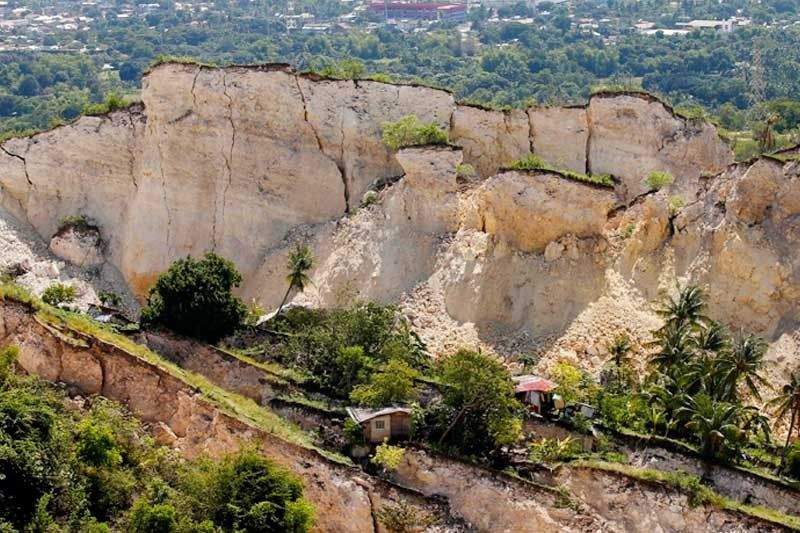Landslides: A personal narrative
By: Erika Florence P. Inez
| La Conchita slump in California. Retrieved from USGS site: http://pubs.usgs.gov/of/2001/ofr-01-0276/ |
Mass wasting is the downslope movement of soil and rock debris due to gravity. It is classified into three major types—falls, slides and flows. Landslides have always been one of the major issues in our country throughout the wet season, especially during the presence of a storm.
Back when I was in second grade, my family and I traveled to Baguio with our family friends for leisure. What was supposed to be a weekend getaway almost turned into a drastic vacation.
My parents have always been the adventurous type. They’ve always liked travelling, and I’m glad they always bring us along with them in most of their escapades. Back in 2011, we went to Baguio to visit the Philippine Military Academy (PMA). Right from the start of our journey, when we were riding the airplane at Mactan Cebu International Airport, we took so much time until we were able to take off so even as an 8-year old, I knew there was something wrong.
When we arrived at Manila very early in the morning, it was chilly. We, then, headed on to Baguio right after, so we wouldn’t be affected by the heavy traffic. When we were headed to Baguio, I was almost asleep the entire time so I don’t remember any other important details aside from the fact that the rain was so heavy, and I heard the radio warning everyone not to go out of their homes because of the storm that hit Luzon.
It was Bagyong Mina (Typhoon Nanmadol).
The strongest tropical cyclone to hit the Philippines in 2011 and unfortunately, for us, Baguio was under Storm Warning Signal #3. When I heard the adults talking about this, I really had no idea what to do. As a young child with little to no knowledge of what’s happening around her, I let the adults do the talking and decide as a team.
When my parents and their friends decided to continue our journey to Baguio amid the storm, I knew we were in for another adventure.
So we proceeded to travel to Baguio. We passed by various landslides, accidents and it even came to the point where the road had zero visibility but we still continued, thinking that if we stop, we would be in much more danger.
While slowly driving and going on, we were hearing stories and news about new deaths and accidents due to the landslides and floods, caused by the storm. Nobody really dared to go out of the house, except from us. The roads were packed with rocks and soil, and even if it was very risky, it was a great thing that the people from Baguio were all cautious of the storm.
I really admire the driver of the van we hired because he was very considerate and cautious. He made sure not to bring us to places with tall pine trees, and he avoided areas where landslides would possibly happen. During that time, Even if I was only a young kid at that time, I can feel the atmosphere inside the van and how everyone was scared, but nobody dared to talk about it. The adults were laughing and joking around to ease the tension while us, kids, were taking pictures and goofing around with them.
It was a long and tiring journey. We even passed by a bus accident in Benguet, which was also caused by a landslide.
On our way home, we still passed by lots of landslides and road mishaps, but it was already safer compared to the time when we arrived in Luzon. That night, we all heard reports about how lots of roads were closed due to the possible landslides and how various road accidents from around our area happened and injured a significant amount of people.
If you think about it, landslides really happen at random occasions and we need to keep in mind that we should always be alert all the time. Also, when faced with landslides and other natural calamities, one should weigh out the pros and cons of a certain decision, just like what the adults did when we learned that there were numerous landslides in our area. In the event that we retreated and decided to go back to Manila, anything bad could’ve happened along the way.
 |
The massive Naga Landslide. Retrieved from https://www.philstar.com/headlines/2018/09/22/1853659/cebu-stops-all-quarrying-forced-evacuation-on
|
In relation to that, one of the biggest tragedies that happened in Cebu is the recent landslide in Naga. The landslide was caused by heavy rainfall and quarrying operations by Apo Land in Naga, killing 78 people on 20 September 2018. In my own experience, everything was in chaos at that time to the point that even the photojournalist who was supposed to judge our contest and lecture us, didn’t attend the talk because he had to cover something regarding the landslide.
Few years after that incident, I am now more aware of the situation during landslides and for me, preparation really is key. If we can conduct earthquake and fire drills, why not landslide drills? Personally, I think one of the main causes of deaths during landslides isn’t only because of the sudden impact, but also because of the lack of knowledge. I believe that the local government units should educate the people and do check various areas in their towns that are landslide prone and evacuate the people living near the areas as soon as possible.
References:
Antojado, L. E. (22 September 2018). Philstar News. Retrieved from https://www.philstar.com/headlines/2018/09/22/1853659/cebu-stops-all-quarrying-forced-evacuation-on
Burgonio, T. (29 August 2011) ‘Mina’ destroys croplands. Inquirer News. Retrieved from https://newsinfo.inquirer.net/49393/%E2%80%98mina%E2%80%99-destroys-croplands.
Salt Lake Community College. Retrieved from http://opengeology.org/textbook/10-mass-wasting.



Comments
Post a Comment